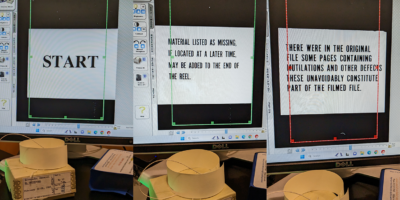By Claire Cahen
About five years ago, I remember nervously anticipating my first teaching assignment. I knew classrooms at the CUNY campuses could be quite large and was worried about how to draw out student voices in a classroom of 40 or so. This turned out to be a moot point; my first semester teaching at CUNY, I was assigned a lecture with 120 students. For most of my academic career, I had been in small seminars. I didn’t know what an effective lecture looked or sounded like. I didn’t have any experiences to model my instruction after. So I waded my way through with many, many hiccups.
But it got easier. In the years that followed, I continued to have classes of anywhere between 50 and 150 students and found that the large classroom has wonderful affordances for both instructors and students. In this blog post, I share some tips for navigating the lecture (and the jumbo lecture) at CUNY.
Planning Your Semester
If you have 50 or more students in your classroom, you can count on having to lecture for some, if not most, of your class sessions. Planning for this kind of pedagogy is its own kind of beast. Before the semester starts, I recommend combing through your syllabus and making sure you’re excited about every topic that’s on there. Unlike in a seminar where much work goes into nurturing student projects and peer-to-peer dialogue, the bulk of your work for a lecture will be preparing to speak in front of the room. This will mean many hours of preparing slides, sourcing short videos and other forms of multimedia, and rehearsing your “talks.” This will be more enjoyable if you are covering subjects you are passionate about. Even if you’ve inherited a syllabus, I recommend inserting topics that you enjoy, concepts at the heart of your own research. For example, when I was assigned a jumbo lecture on the Psychology of Human Sexuality, I leveraged my training in urban studies to create a module on “sex and the city” (the concept, not the TV show). Even my students who were pre-med and had little background in the social sciences told me this was their favorite part of the semester. In some ways this was unsurprising: a lecture is very much a performance. The goal is to keep your students engaged and, while developing your own lecturing persona will take time, your students will sense off the bat if you can communicate not just the content but also affect and excitement. This will be contagious.
As you finalize your pre-semester prep, please remember that readings alone do not make for a strong syllabus in a lecture. In fact, with a large class, you will have no way of knowing how many students have done the reading. Think instead of how you can engage your class by building a narrative or an argument with each lecture. Is there something provocative with which you would like students to engage? Something the room can laugh at, even as you do the bulk of the talking? Something that speaks to their experiences of being-in-the-world? You will have more success if you can structure your lectures to tell a compelling and relevant story.
Moreover, plan to get tired of speaking and for students to get tired of you speaking. I recommend seeking out guest speakers and panels for a few of your classes and pinning down the dates when they will come well in advance. Your students will be thankful for the change of pace.
Finally, you’ll want to think ahead of time about what assessment/coursework strategies are feasible based on your class size. When I was assigned 120 students that first semester, I tried to give my students creative and individualized work throughout the semester. I learned my lesson when I was up past midnight grading on most nights. There is a reason why (Scantron or otherwise automatically-graded) multiple choice-exams are standard in this setting. These aren’t necessarily strong assessment strategies but they are practical and some students have come to prefer them as a masterable skill. There are, understandably, students who hate exams. The best that you can do is to make sure that any stress about grades doesn’t get in the way of learning. To that end, you will want to set any exam dates at the start of the semester and think about how you can help students prep. Think about how you can lower the stakes and give students multiple ways of doing well in the course. You might, for example, give four exams in a semester and automatically drop the lowest grade. You might also give students ample opportunities for extra credit. For example, I’ve given students extra credit for posting discussion questions on our Commons course site, or for introducing guest speakers and moderating Q&As. The key is to balance your workload with student needs. Exams and grading can feel punitive, but they are less so if you are flexible, compassionate, and give students many avenues to do well.
During the Semester
In a large lecture, you bear the responsibility for setting the tone of the classroom. Student dialogue isn’t feasible, so, beginning on the first day of class, you will be communicating to students who you are as an instructor and what kind of classroom environment they will be coming to each week. I like to let my students know from the outset that they are always welcome to “interrupt” the lecture to ask questions or make comments. I use the first class to go over the syllabus, let students know I am rooting for them, and communicate that I am excited to introduce them to the material. I also try to make sure we all get an opportunity to laugh together so that they know that I’m approachable. For example, when I teach the Psychology of Human Sexuality, which is usually a jumbo-lecture in a large auditorium, I borrow a strategy from a colleague of mine. I let students know that, in the class, we will be using words that might be taboo in other courses. I put words like “sex,” “queer,” “genitals,” “polyamory,” and “love” on slides and have us practice saying those words together, such that they ring in chorus through the auditorium. Obviously, no one is required to say anything if they don’t want to, but we usually get to laugh and get comfortable with the subject matter as we move through the vocabulary that is key to the course.
As your semester moves along, know that there will be no replacement for preparing a strong, performative lecture. Again, the bulk of your work will be the prep. Practice your lectures as much as your schedule permits. Know how and when to be dramatic. Watch videos of other faculty lecturing. Listen to podcasts. Take notes on what works. Source multimedia smartly. Don’t rely too much on video but allow short clips to give your class texture and relatability. Give handouts if the lecture is dense. Anticipate that your attendance will fluctuate. Know that certain students will sit in the back of the auditorium and never talk. Do not feel bad. In a large class, some of this is inevitable. Focus on making your lectures compelling and on making yourself as available and approachable as you can. Trust that students know what they need to get out of the course.
During your first few weeks of class, you will also want to scope out the classroom. What are the acoustics like? If students break into pairs or small groups, will they be able to hear each other? How are the students sitting? Are they dispersed throughout a large auditorium? Are most sitting next to at least one other person? Are there chairs that students can move around to sit in a circle for a small group discussion?
Answering these questions will help you determine what kinds of in-class exercises are feasible to break up the monotony of a lecture. As a general rule, auditoriums are not very conducive to small-group discussions. And students may not be able to hear each other very well in a full class discussion. But free-write and pair-share exercises can be fruitful. While the acoustics may not be great, students can usually hear each other if they are talking to just one other person. I like to use free writing to prime pair-shares. For example, I might give students a prompt to reflect on their personal experiences and how these are tied to course material. They then break out into pairs and share with each other. Many are grateful to have a chance to get to know their classmates.
Another strategic way to break up your lecture can be to poll students from the front of the room. It can be fun to set up a front-of-the room “quiz” or game in this way. I have also projected Likert-scale questions such as “how are you feeling today on a scale of exhausted to excited” and given students post-its to place on the canvas.
Supporting Students in a Large Lecture
This brings me to a final topic: how to support your students in a large class where, in all likelihood, you will not know everyone’s names. The first thing to bear in mind is that a lecture is a different type of course: it is less relational than a seminar. Your charisma and ability to speak publicly rather than your trust and relationships with students will drive the class forward. That said, if you can afford to hang back after lecture, you may find your students want to chat informally. This can be lovely. Some students may even want you to write a recommendation letter. If you haven’t gotten a chance to know them because your class size was too large, ask them to sit down with you and tell you about themselves.
In a very large class (100 or more), you will also likely be assigned a T.A. This T.A. may be a graduate student from your program. The dynamics here need not be uncomfortable (though they may be). Decide early on how you want to split responsibilities. If you will be the main lecturer, will your T.A. be the one sending student announcements, grading, holding office hours? If so, do you have another way of communicating with students? Think about what is practical and meaningful. Likewise, if your TA would like to handle parts of the lecture, what will you do that week to support them and your students?
Finally, trust that an effective lecture is a meaningful way to teach, learn, and grow. It is a different type of craft than facilitating a seminar. It takes some practice. But when it works, when your students tell you that things have “clicked,” that they love the material and look forward to class, to listening and laughing together, lecturing is as rewarding as anything else you might do.
Claire Cahen is a PhD candidate in Environmental Psychology and a Fellow at the Teaching and Learning Center.










Leave a Reply